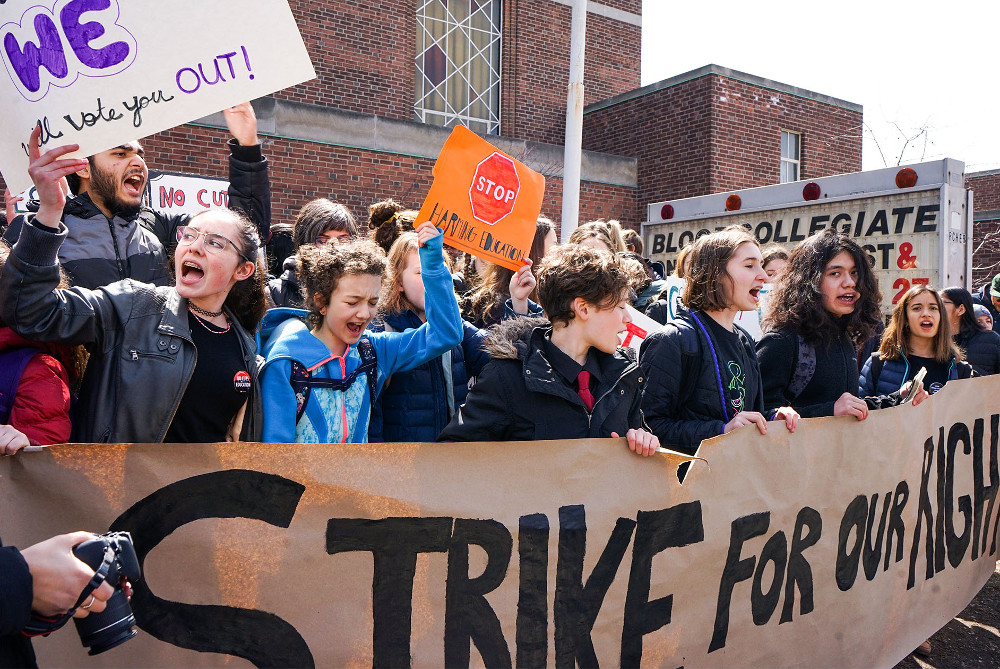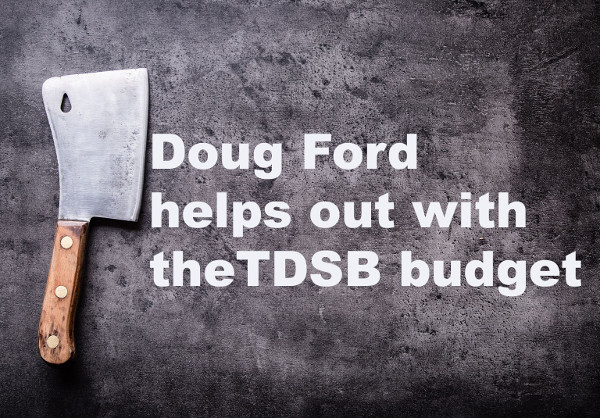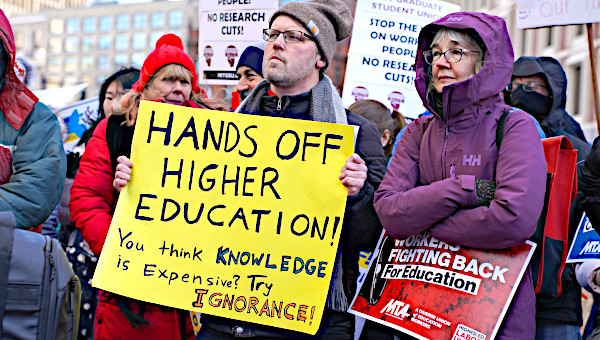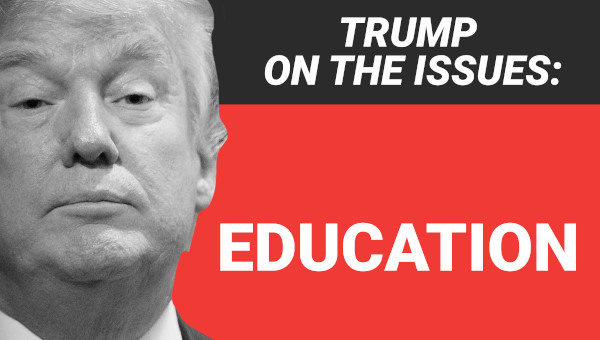Oppose Doug Ford’s Ontario Schools Budget
When it comes down to it, the question is what do we want for our schools?
The government of Doug Ford is actually quite clear about this. It wants to cut money from schools as well as their neighbourhoods, setting them back on their heels and making them more malleable for a government set on hollowing them out. It would like to force schools to privatize, charge more fees, perhaps even offer themselves up for businesses to sponsor them, much in the way that charter schools operate in the USA. The Ford government has brought in so many changes, so quickly, that parents, students and educators have had no time to react to them all.
 There is nothing new about this. In 1997, the Progressive Conservative government of Mike Harris took over funding from all the school boards across the province and squeezed it hard with a funding formula that never worked. It would never take into account the varied needs of different schools in different areas with different populations and stresses upon them. According to a 2015 article “Harris-era Hangovers” by Hugh Mackenzie, the Toronto District School Board (TDSB) has, in most years, faced yawning gaps between what it needs to run schools and programs and what it receives from the government. In 2012, he says that gap was $109-million; the next year there was a further $50-million and in 2014, another $30-million. Whether Liberal or Tory, the gap between what this board needs and what it gets has been pretty much constant.
There is nothing new about this. In 1997, the Progressive Conservative government of Mike Harris took over funding from all the school boards across the province and squeezed it hard with a funding formula that never worked. It would never take into account the varied needs of different schools in different areas with different populations and stresses upon them. According to a 2015 article “Harris-era Hangovers” by Hugh Mackenzie, the Toronto District School Board (TDSB) has, in most years, faced yawning gaps between what it needs to run schools and programs and what it receives from the government. In 2012, he says that gap was $109-million; the next year there was a further $50-million and in 2014, another $30-million. Whether Liberal or Tory, the gap between what this board needs and what it gets has been pretty much constant.
The gap was so bad in 2002, that the TDSB trustees refused to cut $90-million from the budget that year. As a result, the province took over the board and appointed supervisor Paul Christie, who came in and made the cuts he was told to: millions of dollars from caretaking, staff development, vice-principals, supervisors, assistants, secretaries and many others. Yet, in the end, he couldn’t balance the TDSB’s budget for the Tories.
The gap this year is $67.8-million.
What Do We Want for Our Schools?
Schools must have a meaningful curriculum with courses that reflect the widely varied interests of students and enable them to explore and ask questions, without the distractions of standardized tests like EQAO or learning outcomes. Students need to be engaged, active learners and citizens no matter where they come from in the city or their background. Those who are having trouble coping in school must have the support of well-trained individuals like social workers, psychologists, speech and language pathologists and others who can develop sensible strategies to help. Their teachers require the support and advice of other educators who can help them develop their skills and understanding.
Schools must be democratic places with School and Community Councils gaining decision-making power along with the parents, educators and students who rely on them as the centre of their community. They must be free of racism and prejudice. The activities that go on in them need to reflect the backgrounds of the many people who attend them. The educators in them must further their children’s knowledge of the history and culture of Indigenous peoples so they can truly reconcile with them rather than paying lip service in the form of land dedications. To be truly democratic, all activities must be open to all children regardless of their ability to pay.
Schools have to be well-maintained and safe, providing roles for the many adults who tend to the buildings and the children in them. We need to recognize that the different adults who work or volunteer in their schools are as important as teachers in keeping students safe and in giving them a sense of community.
There is nothing radical about any of these ideas. They are reflected throughout the TDSB “budget drivers,” the guides for Board decisions that Director John Malloy referred to frequently last week as he proposed cut after cut to the budgets of 2019 through to 2021. It must have been a heart-wrenching task to dig the grave for public education deeper than ever.
This is a terrible budget and that is not denigrate the efforts of TDSB staff, but to recognize the strictures under which they worked. It comes at a time when there have already been deep cuts to schools. CUPE Local 4400 President John Weatherup fears for the safety of his members employed in helping needy kids who have already seen their support dwindle over the years. Outdoor education for urban children is placed further from their reach. Many staff who support educators will be gone. The efforts the Board has made to hire people who reflect the backgrounds of the kids they teach will be compromised.
I truly sympathize with trustees as they ponder the decisions they have to make about the coming budgets. They worry about explaining to constituents why their schools, already under stress will have less to work with in the coming years. They worry about losses to their local school budgets. They also wonder what to do about it. Do they say “No” to this budget – turn it down and face the inevitable? That could mean once again, a supervisor being appointed to take over their jobs and make the cuts Doug Ford wants. They fear a supervisor would make far worse cuts than the TDSB management has proposed.
Local OSSTF President Leslie Wolfe told School Magazine: “The worst of the damage of the cuts by the Progressive Conservative government is yet to come. At some point trustees may have to say ‘we can no longer do this.’ But I can understand why they wouldn’t want to risk the imposition of a supervisor this early in the term.”
As difficult as it is, I think trustees do need to say “No” to this budget. They were elected to support public education in Toronto – not stand by helplessly and watch as basic principles like equity, safety and quality teaching are sacrificed to the whims of a provincial government that won 40 per cent of the vote in the last election, but acts like a dictatorship. They will lose their credibility as trustees if they go along with this budget. Their opposition to future government budgets won’t be taken seriously.
Cut Expenditures, Turn Down Revenues
Rejecting it could mean a TDSB under supervision and worse cuts. Those might come in future budgets anyway. But, those cuts would be Doug Ford’s alone – the man who says the province is broke, but turns down revenue. Doug Ford should be the person Ontarians turn to when they get sick because public health has been undermined, when their family members die from drug overdoses because he’s cut prevention centres, when they can’t find housing because he’s exempted new rental units from rent control, when their children can’t graduate from their high school because it can’t offer the courses they require, when they no longer get the help they need because the people who could give it to them have been let go, when the ceiling of their children’s school collapses – when schools become warehouses for those who can’t afford a private “choice” – a word of which this government is especially fond.
Doug Ford and his band of cheerleaders must bear the burden of what they have done in the short time they have occupied Queen’s Park. They can’t, as John Weatherup said, go “whistling by the graveyard” as others do their dirty work for them. As cities, boards of health, social advocates, unions and so many more people organize to oppose this government, so too must the trustees of the TDSB and say “No” to this budget. •
TDSB Budget Nightmare
It was a Doug Ford “surprise!” Just as the TDSB was about to release its budget to Trustees on May 13, the Ministry of Education told it to find another $13-million in its pockets. That left the Board with a total of $67.8-million to chew off over the next two years.
 On top of the teacher reductions brought about by increasing class sizes, there are more cuts coming for staff at all levels and programs as well as fees for some activities.
On top of the teacher reductions brought about by increasing class sizes, there are more cuts coming for staff at all levels and programs as well as fees for some activities.
Though there hasn’t been all that much in the local media about it, the budget cuts to Canada’s largest school board is like a hurricane hitting an old house. There will be something left, but what will it be worth?
What Was Supposed to Drive the Budget
As recently as February the TDSB said that the 2019-20 budget would rest on a foundation that included:
- Professional Development – improving teachers’ skills and understanding of issues like racism, human rights, parent engagement and inclusion of students with different backgrounds into classrooms.
- Staff allocation to support the above as well as academics and student mental health.
- Recognizing that the Board needs to stress development of children’s learning in the early years, before widening gaps are harder to close.
- Improving conditions to make students more successful in school, for example in Science, Technology, Engineering, Arts and Math, but particularly those with higher needs, newcomers and kids from low income backgrounds who need access to nutrition programs and the like.
- Including parents through School Councils, advisory committees, workshops and especially making sure that parents of special needs students are “valued partners.”
- Modernizing the Board to reduce paper, give more people wireless access to information, removing physical barriers and improving classroom resources.
- Building relationships with Indigenous communities to help staff better understand the effects of colonization on native people.
Whether or not you agree with these aims or think they go far enough, it’s worth keeping them in mind as we go over what has happened to next year’s budget – and the one for 2020-21 as Doug Ford’s chickens come home to roost at the TDSB.
What Really Drove the Budget
It was cutting $47.8-million in 2019-20 and $20-million in 2020-21. The TDSB has a little wiggle room provided by the $20-million – to ease the cuts a bit for the first year of this two-year plan. But Director John Malloy made it clear in his presentation to trustees, the whole plan must be approved or the province won’t accept it.
Trustees have very little control over where they can move money and they are operating under fire from Doug Ford who calls TDSB’s budget deficit figures “reckless.” Trustee Manna Wong countered that the Ministry of Education has “all our data,” so how can it not know what the Board faces. Mr. Ford has a story he wants to tell and will stick with it because it suits his purpose to cut government by at least 4 per cent.
Highlights
You can see in this chart outlining the proposed changes to the way things work at the Board. It’s an attempt to simplify what the proposals the TDSB put out at the end of last week. But here are some highlights:
Taking a very big hit, are teachers and other staff working centrally for the Board to support teachers and schools. For example, there will be 29 fewer coaches to help classroom teachers deliver the curriculum from Kindergarten to grade 12. Early reading coaches will be down by 8 positions and Guidance support sees 15 fewer staff. Teachers acting as consultants in areas like the Arts, Math, Literacy, Science, Social Studies, Music, ESL, FSL and improving kids chances in school will 32 fewer. Taken together, there will 86 teaching positions lost to the Board. Trustee Jennifer Story told School Magazine “it’s a sad day for the TDSB to have to make cuts that move closer to the classroom.”
And it’s not just the fact that there will be fewer people to meet the same needs. All these teachers have to go back to teaching positions at schools. If they have seniority over more recently hired teachers, they may be in a position to bump less-senior teachers out of a job. School Magazine asked Trustee Shelley Laskin about this possibility. Ms. Laskin said that she didn’t have details yet but had been told there will be few job losses. Trustee Story said that the collective agreement with teachers dictates that central staff returning to classrooms will displace less senior teachers.
She added that these central staff were always there to support front-line teachers, but now many will be gone. There is also the worry that in future years more centrally assigned teachers will have to return to the classrooms to keep class sizes a bit smaller. More teachers, recently hired to reflect the backgrounds of the students they teach, may be gone.
Support Staff Positions Gone
Teachers aren’t the only people helping kids at the TDSB. There is a large contingent of people needed to support students and keep schools running. Principals who work out of different Board office, run Special Education, Early Years, Continuing Education and anti-racism program among others. They are in charge of Outdoor Education and the Urban and Indigenous Education Centre. There will be 13 of them gone in September. The Board will have 10 fewer psychologists to help assess the needs of students. There will be 15 fewer people to support libraries; 23 fewer music instructors to travel from school to school offering programs in strings and steel pan – long an important part of school and neighbourhood culture.
Maintenance Positions Gone
Particularly awful, when the TDSB faces about a $4-billion shortfall in repairs and maintenance to schools, Board management proposes cutting 8 trades staff, 10 summer employment students and – take note – 52 caretakers. Caretakers literally keep schools going. For a board that is already teetering under the effects of mould, falling ceiling tiles, tar dripping down into classrooms, outdated heating and cooling systems, old leaky windows, cracked floors, unpainted buildings – the list goes on – you need not fewer, but more caretakers just to keep the schools safe.
CUPE 4400 is the union that represents these and other education workers at the TDSB. Its local president John Weatherup, says that the losses of his members adds up closer to 100 since more than 30 have already been told that they won’t have jobs in September. He adds that between 20 and 30 office staff as well as more than 30 Special Education Assistants will need to look for other work in September.
These are all losses to a board that has seen stable enrollment over the past 5 years.
Outdoor Education: Increased Fees
There’s more. For urban kids, Outdoor Education programs have long been critical parts of school life. Many kids have little way of getting out of the city or getting up close to forests and the animals in them. The Board proposes that 4 of the 10 Outdoor Learning Centres be closed. For those that remain open, it will cost more for kids to visit them.
Depending on a school’s position on the Learning Opportunities Index that measures neighbourhood income, education, family financial stability and overall stress – fees will go up. For a school low on the index, fees will go up to $5 per child for a day trip and $50 overnight if it can manage to book a trip in one of the fewer centres. On the other hand, well-to-do students will pay $15 for a day trip and $150 to stay overnight.
TDSB management is doing a little dodge with transportation to those centres. Starting in 2020 -21 it will move $700,000 in transportation costs off its books and onto the school budgets. A saving for the Board, but not for its schools who will have to pony up the cost for getting kids to the Outdoor Education centres. It also speaks vaguely about how it could “restructure staffing and program delivery model.” There are no details about it, but it sounds like a staffing cut.
School Budgets
On the topic of schools, their budgets could be cut by 5 per cent, if the management proposal is passed by trustees. The amount of the cut would depend upon a school’s size, family income and access to fundraising money. This last point will become a greater issue as schools will compete more for the same money. It also shows where schools are headed: they will need more access to private money to run simple events like sports, days, plays, field trips and artist visits. As the TDSB has less and less money to even out the already glaring disparities between schools, any notion of equity goes out the window. Trustee Chris Moise understands this well. With his downtown schools in neighbourhoods marked by poverty, he says that his schools need extra money for there to be equity in the Board.
TDSB management suggests that it cut the Saturday program for International languages that works with 7500 students at 29 sites teaching 50 languages. It would cut a day program at 10 sites teaching 3300 students 6 languages. There is no mention of staff cuts here, but CUPE’s John Weatherup expects to see about 300 layoffs.
It would also cut the elementary school International Baccalaureate (IB) Program, that it says fosters collaboration, leadership, critical thinking and a sense of global citizenship – all elements of what should be going on in classrooms anyway. It would keep the secondary school IB Program and would help to cover fees for low income students. It doesn’t say what those fees would be. There is also no mention of the number of staff positions that would disappear.
Trading to Delay Busing Cuts
These are some of the main cuts for students, school and programs over the next 2 years. But there is another wrinkle. Just after TDSB trustees received the budget proposal, they asked Board management staff to go back and rework its transportation part of it. That was because to make up the extra $13-million the Ford government lopped off the TDSB budget, Board staff proposed it eliminate busing for all French Immersion and Extended French students. Trustees said this would be too much to handle for the 2019 – 20 school year. Parents wouldn’t be able to make other arrangements in time.
So they bought some time. Board staff presented this plan:
- Keep French Immersion and Extended French busing from Senior Kindergarten to grade 8 for 2019-20
But:
- Eliminate it, as well as busing for Gifted students in elementary schools for 2020-21
- No longer give TTC tokens to French Immersion, Extended French and Gifted students in secondary school
Savings:
- 2019 – 20: $1.3-million
- 2020 – 21: $7.7-million
That’s not enough for the government. It wants more money to come out of the 2019-20 budget. So, the trustees were presented this option:
For 2019-20
- Reduce professional development.
- Reduce supply teacher costs in Secondary Schools. As teaching positions disappear with the class size increase, the reasoning goes that fewer teachers will need fewer supply teachers – a faint hope at best.
- Cut 11 more staff positions from the Leadership and Learning departments.
- Cut 12 more K-12 Learning Coach positions.
- Cut 3 Speech and Language Pathologist positions.
- Cut 4.5 Social Work positions.
Saving:
- 2019 – 20: $7.3-million
Then for 2020-21:
- Put all of the above positions back in place.
What happens at the end of 2021 and all of this chaos?
The TDSB will have done a bit more than what the Doug Ford government has required, cutting $47.6-million from students in 2019-20 and $21.65-million in 2020-21. That’s a total of $69.3-million. So far, at least. •
These articles first published on the School Magazine website.





